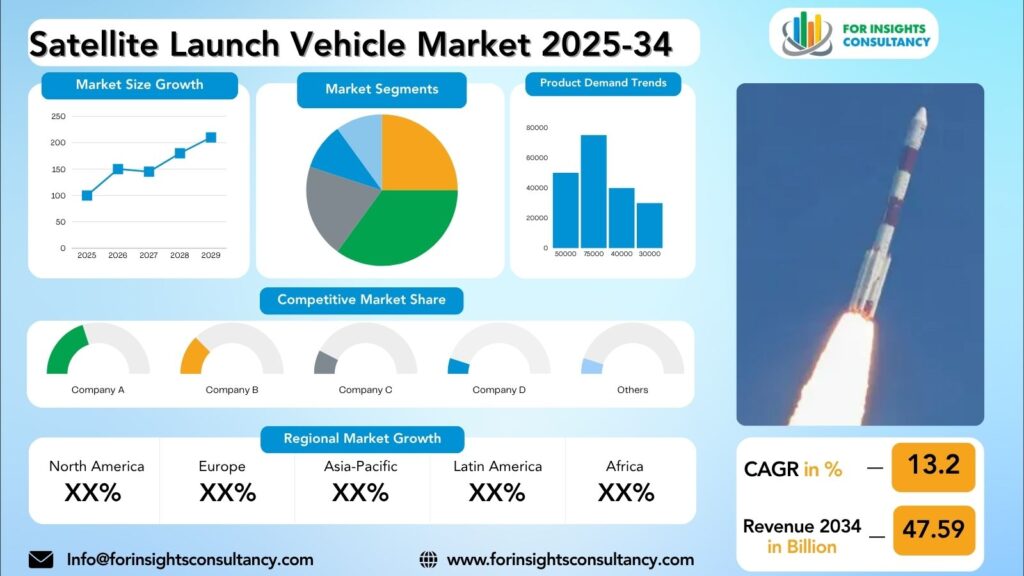
Satellite Launch Vehicle Market Size, Trends Analysis Research Report By Launch Type/Category (Single-Use/Expendable Launch Vehicle (ELV), Reusable Launch Vehicle (RLV)), by Orbit Type (Destination), By Payload Capacity, by End-User, And by Vehicle Type, and By Region Global Market Analysis And Forecast, 2025-2034
Sep-2025 Formats | PDF | Category: Aerospace| Delivery: 24 to 72 Hours
The report highlights that the market outlook is significantly influenced by swift shifts in global trade relations and tariffs. It emphasizes the necessity of updating the report before delivery to incorporate the most current status, which includes revised market forecasts and a comprehensive analysis of the quantified impacts of these changes. Specifically, the Recommendations and Conclusions sections will be enhanced to provide actionable strategies for organizations navigating the rapidly evolving international landscape.
Satellite Launch Vehicle Market Is Forecast to Increase from USD 23.4 Billion In 2025 To USD 47.56 Billion By 2034, At A CAGR Of 13.2%.
Satellite Launch Vehicle Market: A Comprehensive Overview and Future Developments
The satellite launch vehicle market is experiencing significant growth, driven by rising demand for satellite launches and advancements in technology. Key industry players are making substantial investments to improve efficiency and decrease costs through innovative strategies. Notably, the emergence of reusable launch vehicles and enhancements in propulsion systems are poised to propel the market forward in the coming years. Collaborations between space agencies and private companies are anticipated to further drive market expansion and create new deployment opportunities for satellites. In summary, the market is advancing rapidly, with an emphasis on enhancing capabilities and sustainability for future missions.
The Satellite Launch Vehicle Market is pivotal across various global industries, with technological advancements significantly influencing sectors such as telecommunications, remote sensing, weather forecasting, national security, and scientific research. The emergence of more efficient and cost-effective satellite launch vehicles has transformed communication systems, enhancing connectivity and improving data transmission on a global scale. In remote sensing, these technologies facilitate accurate mapping, monitoring, and data collection, which is vital for agriculture, urban planning, and environmental conservation efforts.
Additionally, satellite launch vehicles have markedly improved weather forecasting capabilities, which in turn bolster disaster preparedness and response strategies. Their role in national security is also notable, as they assist in surveillance and intelligence operations. In the realm of scientific research, these vehicles are essential for conducting missions that explore outer space and performing experiments in microgravity conditions.
In summary, the Satellite Launch Vehicle Market is at the forefront of innovation and progress, influencing a broad spectrum of industries and fundamentally shaping our interactions with the world. Its continuous advancements drive improvements in technology and methodology across these critical sectors.
AI Impact
The satellite launch vehicle market is undergoing a transformative change due to the integration of artificial intelligence (AI) technologies. AI is significantly optimizing launch processes, which enhances overall efficiency and elevates safety protocols. By employing advanced AI algorithms, the industry is capable of analyzing extensive datasets to forecast potential challenges preemptively, enabling proactive maintenance strategies that minimize the risk of launch failures. Furthermore, AI is improving navigation systems, facilitating more accurate trajectory calculations that ensure the precise positioning of satellites in their intended orbits. Collectively, these advancements signify that AI is not only fostering innovation within the satellite launch vehicle sector but also leading towards more dependable and economically viable launch operations.
Market Dynamics
Trends
The Satellite Launch Vehicle market is experiencing transformative trends that are significantly influencing its trajectory. A prominent trend is the surge in demand for small satellite launches, largely fueled by advancements in miniaturization technology and an increasing need for cost-effective launch solutions. This shift is accommodating smaller payloads and enabling a greater number of entities, including startups and research institutions, to access space. Another noteworthy trend is the rise of reusable launch vehicles, which promise substantial cost savings, promote sustainability, and minimize environmental impact due to reduced waste from single-use rockets. Furthermore, the industry is witnessing a growing inclination towards commercial partnerships and collaborative efforts between private aerospace companies and government organizations. These partnerships are fostering innovation, streamlining operations, and contributing to the reduction of overall launch costs. As these trends evolve, they are anticipated to drive sustained growth and technological improvements within the Satellite Launch Vehicle market in the upcoming years, highlighting an ongoing shift towards more efficient, environmentally friendly, and accessible space exploration and utilization.
Growth Drivers
The Satellite Launch Vehicle Market is currently undergoing substantial growth, driven by multiple factors. The escalating need for satellite launches across various applications, including communication, navigation, and earth observation, is a primary catalyst for this market expansion. In parallel, technological advancements have introduced cost-effective and efficient satellite launch vehicles, encouraging broader participation from different market players. Furthermore, the increasing enthusiasm for space exploration and the deployment of commercial satellites are contributing to this upward trend. Additionally, government initiatives and partnerships between space agencies and private sector companies are playing a vital role in further propelling the development of the satellite launch vehicle market. Collectively, these factors suggest a promising and robust future for the industry.
Restraints
Restraints in the Satellite Launch Vehicle (SLV) Market encompass several critical challenges that could potentially hamper growth and innovation within the sector. Key issues include high manufacturing costs that elevate the financial barrier for entry and operations, as well as stringent government regulations that impose compliance requirements impacting development timelines and operational flexibility. The limited payload capacity of existing vehicles further constrains market offerings, restricting the volume and types of missions that can be economically undertaken.
Moreover, the competition posed by reusable rocket technologies presents a significant challenge as these innovations aim to reduce costs and increase launch frequency, potentially disrupting traditional SLV providers. Additionally, geopolitical tensions may create uncertainties that impact international collaborations, which are often essential for pooling resources and expertise in the highly specialized field of satellite launches.
The market is also burdened by other critical factors, such as the necessity for reliable communication and navigation systems, which are vital for successful launch and operation of satellite missions. The management of space debris represents a growing concern, necessitating developments in tracking technologies and operational protocols to prevent collisions. Environmental concerns surrounding rocket launches, including emissions and their broader ecological impact, are becoming increasingly prominent, leading to calls for more sustainable practices within the industry.
Addressing these multifaceted restraints will require significant innovation and strategic partnerships, accompanied by continuous investment in research and development. These efforts are essential to enhance efficiency, overcome technological hurdles, and promote sustainability, ultimately fostering growth in the satellite launch vehicle market.
Opportunities
The Satellite Launch Vehicle Market presents significant prospects for growth and innovation primarily fueled by an escalating demand for satellite launches catering to communication, navigation, earth observation, and scientific research. As the need for reliable and efficient launch vehicles intensifies, companies are urged to leverage this momentum by developing cost-effective and reusable launch vehicles, along with adopting competitive pricing strategies and broadening their global market presence. Technological advancements, including electric propulsion and 3D printing, further enhance the performance and sustainability of these vehicles, providing additional avenues for development. By prioritizing innovation and effectively responding to the changing needs of the sector, companies are positioned to thrive in the increasingly competitive landscape of the satellite launch vehicle industry.
Challenges
The Satellite Launch Vehicle Market confronts various hindrances affecting its expansion and functionality. Key issues include the exorbitant costs related to research, development, and production processes; rigorous regulatory frameworks governing space missions; the restricted payload capacities of current launch vehicles; and the imperative for cutting-edge technologies to satisfy the surging demand for satellite launches. Furthermore, the rise of new private space firms, specifically SpaceX and Blue Origin, presents formidable competition to traditional government space agencies and longstanding aerospace entities. To overcome these challenges, there is a pressing need for strategic investments in innovation, enhanced collaboration among industry stakeholders, and a dedicated focus on crafting sustainable and cost-efficient methodologies for satellite launch operations.
Satellite Launch Vehicle Market Top Companies Covered In This Report:
Evaluate The Strategic Positioning And Innovation Pipelines Of Leading Market Companies-From Multinational Enterprises To Disruptive Regional Firms. Understand How Key Players Are Innovating, Expanding, And Capturing Value, And Use Competitive Benchmarks To Plan Your Next Move.
- ISRO (Indian Space Research Organisation)
- Lockheed Martin Corporation
- Arianespace
- Blue Origin
- Boeing Defense, Space & Security
- Firefly Aerospace
- United Launch Alliance (ULA)
- Virgin Orbit
- Mitsubishi Heavy Industries, Ltd.
- Northrop Grumman Corporation
- Relativity Space
- Rocket Factory Augsburg (RFA)
- Rocket Lab USA, Inc.
- SpaceX
Satellite Launch Vehicle Market Company News 2024 and 2025
Arianespace
Europe’s new heavy-lift rocket, Ariane 6, successfully completed its inaugural demonstration flight from Europe’s Spaceport in French Guiana in 2024. This flight was critical for reinstating Europe’s autonomous access to space following the retirement of Ariane 5.
Following the inaugural flight, the first commercial missions of the Ariane 6 (e.g., Flight VA263 and VA264) have begun in 2025, launching institutional and commercial satellites, including major weather and Earth observation payloads.
United Launch Alliance
The first national security launch on the Vulcan Centaur (e.g., USSF-106) was successfully completed in 2025, carrying critical military and experimental payloads directly into high orbits.
ULA is ramping up its launch cadence, aiming to replace its legacy Atlas V and retired Delta IV rockets with the new, more cost-competitive Vulcan.
SpaceX
SpaceX continues its unprecedented launch frequency, supporting its own Starlink constellation deployment and a high volume of commercial and government missions using the reusable Falcon 9 and Falcon Heavy rockets.
Segmented View of The Industry:
The Satellite Launch Vehicle Market Is Mapped Through A Multidimensional Lens-Tracking Shifts Across Product Type, Applications, And Geographic Regions. This Segmented Approach Enables Businesses to Localize Their Growth Plans And Align Offerings With The Most Profitable Demand Centres.
Segmentation By Launch Type/Category
- Single-Use/Expendable Launch Vehicle (ELV)
- Reusable Launch Vehicle (RLV)
Segmentation By Orbit Type
- Low Earth Orbit (LEO)
- Medium Earth Orbit (MEO)
- Geostationary Orbit (GEO)
Segmentation By Payload Capacity
- Small Payload/Nano & Micro Satellites- Typically <500 kg
- Medium Payload- Typically 500 kg – 2,500 kg
- Heavy Payload- Typically >2,500 kg
Segmentation By Vehicle Type
- Small Launch Vehicle (SLV)
- Medium to Heavy-Lift Launch Vehicle (MLV/HLV)
Segmentation By End-User/Application
- Commercial
- Government & Military
Global Geographic Coverage:
The Report Provides In-Depth Qualitative And Quantitative Data On The Satellite Launch Vehicle Market For All Of The Regions And Countries Listed Below:
North America
The satellite launch vehicle market represents a vital sector within the aerospace industry, characterized by its notable growth potential on a global scale. In North America, this market is notably led by the United States and Canada, both of which have developed strong footholds in space exploration and satellite launch capabilities.
The United States stands at the forefront of this market, thanks to its sophisticated technology and substantial infrastructure for satellite launches. Key organizations, such as NASA, alongside private enterprises like SpaceX, play a crucial role in reinforcing the country’s dominance. Continuous investment in research and development further ensures that the U.S. remains competitive on the international stage.
Conversely, Canada’s space industry is undergoing rapid expansion, marked by its emphasis on innovative technologies and strategic collaborations with global partners. The country’s advancements in both satellite technology and launch vehicles have enabled it to emerge as a significant contributor to the North American market.
Europe
The Satellite Launch Vehicle Market in Europe is a robust and expansive sector, with multiple countries significantly contributing to its growth and development. France is a notable player, primarily due to the presence of the European Space Agency’s spaceport in French Guiana, which serves as a key launch site, offering access to various orbital inclinations. This strategic location enhances France’s ability to cater to diverse satellite deployment needs.
Germany stands out with a strong industrial presence, led by major companies such as OHB System and Airbus Defence and Space, which excel in both satellite manufacturing and launch services. Their innovative approaches and established expertise are pivotal in maintaining Germany’s competitive edge in the market.
Italy is also becoming an increasingly influential participant, bolstered by the initiatives of the Italian Space Agency, which fosters collaboration with other European entities, thereby enhancing the synergy within the European satellite launch market.
Spain has made remarkable advancements in this arena as well, with companies like PLD Space pioneering innovative launch solutions that contribute to the region’s technological advancements and capabilities in satellite deployment.
Despite facing regulatory hurdles following Brexit, the United Kingdom remains a significant contributor to the European Satellite Launch Vehicle Market. Companies such as Skyrora and Orbex continue to innovate and push forward the UK’s role in space exploration.
Asia Pacific
The Satellite Launch Vehicle Market in the Asia Pacific is experiencing substantial growth, driven by heightened demand for satellite launches across various sectors including communication, navigation, remote sensing, and scientific research. China’s significant investments in its space programs have established it as a pivotal player in the global market, with the China Aerospace Science and Technology Corporation (CASC) prominent among the key entities, particularly through its Long March series of launch vehicles. India’s advancements are also noteworthy, as the Indian Space Research Organisation (ISRO) has successfully launched satellites for both domestic and international customers. The Polar Satellite Launch Vehicle (PSLV) from ISRO has earned a reputation for its cost-effectiveness and reliability, further solidifying India’s position in the sector. Other notable contributors in the region include Japan, South Korea, and Australia, each supported by their respective space agencies that enhance satellite launch capabilities. The Asia Pacific region is expected to continue its growth trajectory in the satellite launch vehicle market, fueled by technological advancements and increasing international collaboration, which are fostering innovation and enhancing competitiveness in this dynamic field.
Middle East and Africa
The Satellite Launch Vehicle Market in the Middle East and Africa is experiencing notable growth due to technological advancements and heightened interest in space missions among various nations. In the Middle East, significant investments have been made by countries such as the United Arab Emirates (UAE) and Saudi Arabia in their respective space programs. The UAE’s space agency has actively launched several satellites utilizing its indigenous launch vehicles, which has propelled the expansion of the regional market. Meanwhile, Saudi Arabia is establishing itself as a significant competitor by developing its own satellite launch vehicle initiatives.
In the African landscape, Nigeria and South Africa are at the forefront of space exploration, with Nigeria successfully launching satellites aimed at communication and earth observation. South Africa’s space agency is similarly engaged in developing satellite technology, reflecting a growing commitment to harnessing space capabilities.
Collectively, the Middle East and Africa are well-positioned for substantial growth in the Satellite Launch Vehicle Market, supported by increasing investments in space programs and an escalating demand for satellite launches across diverse applications. This progress underscores a broader regional ambition to enhance technological capabilities and harness the benefits of space.
Reasons To Buy:
- The Research Would Help Top Administration/Policymakers/Professionals/Product Advancements/Sales Managers And Stakeholders In This Market In The Following Ways.
- The Report Provides Satellite Launch Vehicle Market Revenues At The Worldwide, Regional, And Country Levels With A Complete Analysis To 2034 Permitting Companies To Analyze Their Market Share And Analyze Projections, And Find New Markets To Aim For.
- To Understand The Most Affecting Driving And Restraining Forces In The Market And Their Impact On The Global Market.
- Major Changes And Assessment In Market Dynamics And Developments.
- The Objective Of The Satellite Launch Vehicle Market Report Is To Identify New Business Opportunities Using Quantitative Market Forecasts.
- Formulate Sales And Marketing Strategies By Gaining An Understanding Of Competitors, Their Positioning, And Strengths & Weaknesses.
Faq – What Global Leaders Are Asking
What Is The Growth Prospect For The Satellite Launch Vehicle Market By 2034?
Satellite Launch Vehicle Market Is Expected To Achieve A Stable Growth Rate With A Compound Annual Growth Rate (CAGR) Of About 13.2% From 2025 Through 2034.
What Is Driving The Growth Of The Satellite Launch Vehicle Market?
The primary growth driver is the rising global demand for satellite mega-constellations for communication, Earth observation, and defense purposes. This demand is facilitated by advancements in reusable launch vehicle technology, which dramatically reduce the cost and increase the frequency of launches.
This escalating threat landscape is compounded by accelerated digital transformation (cloud migration, remote work) and stringent global regulatory compliance.
Who Are The Key Players In The Satellite Launch Vehicle Market, And What Are Their Market Shares?
The Satellite Launch Vehicle Market Includes Major Companies Like ISRO (Indian Space Research Organisation), Lockheed Martin Corporation, Arianespace, Blue Origin, Boeing Defense, Space & Security, Firefly Aerospace, United Launch Alliance (ULA), Virgin Orbit, Mitsubishi Heavy Industries, Ltd., Northrop Grumman Corporation, Relativity Space, Rocket Factory Augsburg (RFA), Rocket Lab USA, Inc., SpaceX, Others.
Specific Market Share Data Is Not Publicly Available And Is Typically Provided In Detailed, Proprietary Market Research Reports.
Which Regions Are Leading The Satellite Launch Vehicle Market Growth?
North America holds the largest market share, driven by major private companies like SpaceX and Blue Origin, and strong government investment. Asia-Pacific is the fastest-growing region, fueled by expanding national space programs in countries like China and India.
Customization: We Can Provide Following Things
1) On Market More Company Profiles (Competitors)
2) Data About Particular Country Or Region
3) We Will Incorporate The Same With No Additional Cost (Post Conducting Feasibility).
Any Requirement Contact Us: Https://Www.Forinsightsconsultancy.Com/Contact-Us/
Table of Contents
For TOC Contact us: https://forinsightsconsultancy.com/contact-us/







